Homer IPT Multiple Trip Discounts Increased
Save $1,500.00 by doing back-to-back trips. Save $2500 by doing all three trips. If you sign up with a friend or a spouse, please e-mail for couples’ discount info.
Fall 2022 Fort DeSoto Instructional Photo-Tour #3 Late Registration Discount Info
If you are interested in learning about the late registration discount offer for the third Fort DeSoto IPT, please get in touch via e-mail
On Getting Better
Consider joining me on a BIRDS AS ART Instructional Photo-Tour (IPT). The DeSoto, San Diego, Homer, and the yet-to-be announced July 2023 Jacksonville and July 2024 Galapagos Photo-Cruise of a Lifetime all offer the opportunity for you to dramatically improve your skills both in the field and at the computer and to make some astounding images as well. Click here and see which IPT might be best for you.
Attention NANPA Members
If you are currently a NANPA member who enjoys and benefits from your membership and would like to see the organization grow and improve, please contact me via e-mail on a matter of urgent importance.
|
|
All images from Homer or Kachemak Bay, AK |
2023 Homer/Kachemak Bay Bald Eagle IPTs
IPT #1: MON 20 FEB 2023 through the full day on FRI 24 FEB 2023. Five full days/20 hours on the boat: $5500.00. Limit 5 photographers/Openings: 2.
IPT #2: SAT 25 FEB 2023 through the full day on THURS 2 MAR 2023. Six full days/24 hours on the boat: $6600.00. Limit 5 photographers/Openings: 3.
IPT #3: FRI 3 MAR 2023 through the full day on TUES 7 MAR 2023. Five full days/20 hours on the boat: $5500.00. Limit 5 photographers. Openings: 2.
Save $1,500.00 by doing back-to-back trips. Save $2500 by doing all three trips.
These trips feature non-stop flight photography as well as many opportunities to create both environmental and point-blank portraits of one of North America’s most sought-after avian subjects: Bald Eagle (Haliaeetus leucocephalus). Other reliable subjects will include Sea Otter, Glaucous-winged and Short-billed (formerly Mew) Gulls.
In addition, we should see Common Murre, Black Guillemot, Pelagic Cormorant, two or three species of loons, and a smattering of ducks including two species of merganser, all three scoters, Common and Barrow’s Goldeneyes, Bufflehead, Harlequin, and Long-tailed Ducks. Close-range photographic chances for these species will require a ton of good luck. Some of these species, especially when in flocks, can, however, often be used effectively when creating bird-scapes.
If we need to be out early, we will be the first boat out. If conditions are great, we will stay out. And when there is a chance for sunset silhouettes, we will stay out and be in the right spot.
We will be traveling through gorgeous wilderness country; landscape and scenic opportunities abound.
Also featured is a professional leader, often referred to as the world’s most knowledgeable bird photography trip leader, who is conversant in Canon, Nikon, and Sony.
|
|
All images from Kachemak Bay in 2022! |
What You Will Learn
You will learn practical and creative solutions to everyday photographic problems. You will learn to see the shot, to create dynamic images by fine-tuning your compositions, to best utilize your camera’s AF system, and how to analyze the wind, the sky conditions, and the direction and quality of the light. This is one of the very few trips Homer trips available where you will not be simply put on the birds and told to have fun. You will learn to be a better photographer. But only if that is what you want.
You will learn to get the right exposure when it is sunny, when it cloudy-bright, when it is cloudy, when it is cloudy-dark, or when it is foggy. Not to mention getting the right exposure when creating silhouettes.
You will learn to make pleasing blurs working in manual mode and to create silhouettes working in Shutter Priority mode.
Most importantly you will learn to pick your best flight images from tens of thousands of images.
You will enjoy working with the two best and most creative boat captains on their sturdy, photography-spacious, seaworthy, open-deck crafts.
The second and third IPTs are the only Bald Eagle workshops that feature an incredibly helpful first mate.
Only five photographers (not the usual six), plus the leader.
Small group Photoshop, Image Review, and Image Critiquing sessions.
|
|
All images from Homer or Kachemak Bay, AK |
What’s Included
One four hour or two two-hour boat trips every day (weather permitting), all boat fees and boat-related expenses (excluding tips), ground transportation to and from the dock and back to the hotel each day, in-the-field instruction and guidance, pre-trip gear advice, small group post-processing and image review sessions, and a thank you dinner for all well-behaved participants.
What’s Not Included
Your airfare to and from Homer, AK (via Anchorage), the cost of your room at Land’s End Resort, all personal items, all meals and beverages, and tips for the boat captain and/or the first mate.
Please Note
On great days, the group may wish to photograph for more than four hours. If the total time on the boat exceeds 20 hours for the five-day trips, or 24 hours for the second trip, the group will share the additional expense at a rate of $225/hour.
Some folks may wish to rent their own vehicle to take advantage of local photographic opportunities around Homer.
Deposit Information
A $3000 non-refundable deposit/trip is required. You may pay your deposit with credit card or by personal check (made out to BIRDS AS ART) and sent via US mail only to Arthur Morris. PO Box 7245. Indian Lake Estates, FL 33855. Your balance, due 90 days before the date of departure, is payable only by check as above.
In Closing
I have been going to Homer off and on for close to two decades. Every trip has been nothing short of fantastic. Many folks go in mid-March. The earlier you go, the better the chances for snow. The only way to assure that you are on the best of the three trips is to sign up for all three. Can you keep up with me? If you have any questions, or are good to go for one, two, or all three trips, please let me know via e-mail or give me a call on my cell phone at 863-221-2372.
What’s Up?
Monday was another day of all work and no play. I’ve been swimming two half-mile sessions daily and eating very well. I was thrilled to learn that many multiple IPT-veteran John Dupps will be joining me on the second San Diego IPT and that Galapagos registrant Vasili Chernishof will be attending the first Homer IPT. With Homer now more than half full, do not wait too long if you wish to join me there.
Today is Tuesday 18 October 2022. I fly to Oklahoma City on Thursday for OKC PhotoCon. Wherever you are, and whatever you are doing, I hope that you too have a great day. This blog post took about an hour to prepare and makes two hundred-six days in a row with a new one.
Please remember to use the B&H and Amazon links that are found on most blog pages and to use the BIRDSASART discount code at checkout when purchasing your new gear from Bedfords to get 3% back on your credit card and enjoy free second-day air FedEx. Please, also, consider joining a BAA IPT. You will be amazed at how much you will learn!
Your Call
Which of today’s two featured images do you like best? Please leave a comment and let us know why you made your choice. Thanks with love for that, artie.
Iceland
My decades-long dream of spending time with the puffins on Grimsey Island, Iceland — 13 days in this case! — will be realized this coming July. If anyone else would like information on the world’s greatest Iceland/Atlantic Puffin trip this coming July, please contact me via e-mail.
Follow me on Instagram here. I am trying to feature both new and old images, especially images that have not appeared recently on the blog. Or search for birds_as_art.
BIRDS AS ART Image Optimization Service (BAA IOS)
Send a PayPal for $62.00 to birdsasart@verizon.net or call Jim at 863-692-0906 and put $62.00 on your credit card. Pick one of your best images and upload the raw file using a large file sending service like Hightail or DropBox and then send me the link via e-mail. I will download and save your raw file, evaluate the exposure and sharpness, and optimize the image as if it were my own after converting the raw file in Adobe Camera Raw. Best of all, I will make a screen recording of the entire process and send you a link to the video to download, save and study.
Induro GIT 304L Price Drop
Amazingly, we have two, brand-new-in-the-box Induro GIT 304L tripods in stock. They are $699.00 each (were $799.00) and the price now includes the insured ground shipping to the lower 48 states. Weekday phone orders only: 863-692-0906. Order yours here while they last.
Two Square Sunny Bald Eagles
|
|
|
This image was created on 26 February 2022 on an Instructional Photo-Tour at Kachemak Bay, Homer, AK. I used the hand held Sony FE 70-200mm f/2.8 GM OSS II lens with the Sony FE 1.4x Teleconverter (at 280mm) and The One, the Sony Alpha 1 Mirrorless Digital Camera.. The exposure was determined via Zebras. ISO 640: 1/3200 sec. at f/6.3 (stopped down 1 1/3-stops) in Manual mode. AWB at 2:43:09pm on a sunny afternoon. Tracking: Zone AF/C with Bird-Eye/Face Detection performed perfectly. Click on the image to enjoy a high-res version. Image #1: Bald Eagle adult beginning to dive |
Exposure Basics
On cloudy days, the meter in your camera is dead-solid stupid. In situations with overall light-toned backgrounds you will need to add from two to four, yes, four, stops of light to the exposure value suggested by your in-camera metering system. That is true be it Evaluative (Canon), Matrix (Nikon), Multi-metering (Sony), or whatever is the (supposedly) most sophisticated metering pattern with your current system.
On sunny days, these same metering systems are much smarter; most of the time you will need to add or subtract only one- or two-thirds of a stop of light to make perfect exposures. Remember that when using Manual exposure mode for your bird photography (or anything else), there is no “exposure compensation” (EC). Relying on Sony’s Zebras, I rarely look at the analogue scale to note how the exposure I have set compares to the exposure suggested by the camera. The difference that you note would equate to the EC.
|
|
|
This image was also created on 26 February 2022 on an Instructional Photo-Tour at Kachemak Bay, Homer, AK. I used the hand held Sony FE 70-200mm f/2.8 GM OSS II lens with the Sony FE 1.4x Teleconverter (at 249mm) and The One, the Sony Alpha 1 Mirrorless Digital Camera.. The exposure was determined via Zebras. ISO 500: 1/4000 sec. at f4 (wide open) in Manual mode. AWB at 2:46:41pm on a sunny afternoon. Tracking: Zone AF/C with Bird-Eye/Face Detection performed perfectly. Click on the image to enjoy a high-res version. Image #2: Bald Eagle adult checking things out |
Homer Weather
The weather in Homer, AK in winter is incredibly variable. Daily high temperatures range from 32°F to 34°F, rarely falling below 18°F or exceeding 43°F. The daily low temperatures are around 23°F, rarely falling below 5°F or exceeding 35°F. The past few years have been unseasonably warm. Sky conditions vary tremendously and can change in minutes, and the same is true of wind speeds and directions. We do not have a set-in-stone schedule on any IPT as we adjust it daily based on the weather, the sky conditions, the wind direction and strength, and local conditions. In Homer, we meet for breakfast just as it is getting light. I look out the big window in the restaurant at Land’s End Resort, call the captain, and arrange a meeting time. And so it goes for the rest of the day as we may stay out all day or cancel. Every trip for as long as I can remember exceeds the total- hours-on-the-boat plan of four hours/day. On cloudy bright days we may photograph for as long as eight hours! And we always head out when there is a chance for decent sunset colors.
The variable weather enables you to return home with new knowledge regarding the relationship between sky conditions and the wind. In addition, and most importantly, you will learn to get the right exposure when working in conditions ranging from cloudy-dark to complete sun. Do consider joining me this winter.
Another huge learning opportunity is available to you ever day as we edit our images — pick our keepers from as many as ten thousand or more from a single session. Shooting very conservatively, I rarely exceed four or five thousand images even on a great morning. Last year some folks created from ten to more than twenty thousand images on a single day. Your understanding of ideal wing positions and flight poses will be increased exponentially. As will the total package of your photography skills.
Typos
With all blog posts, feel free to e-mail or to leave a comment regarding any typos or errors.

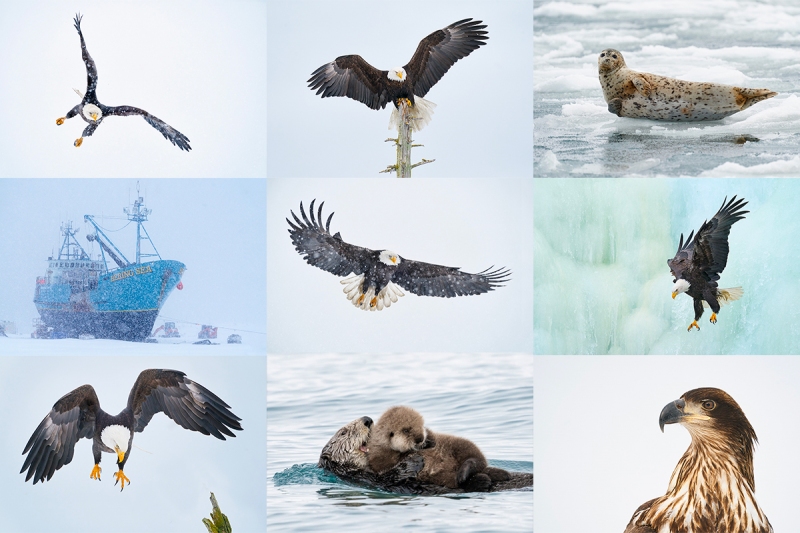
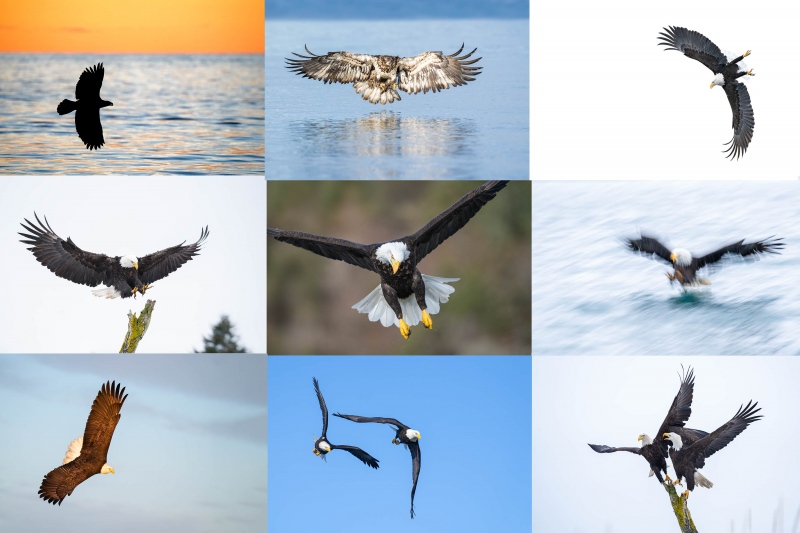
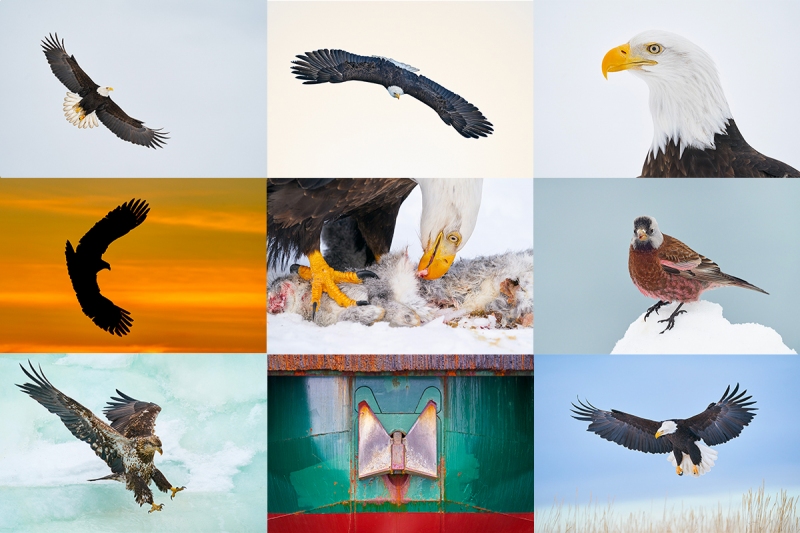
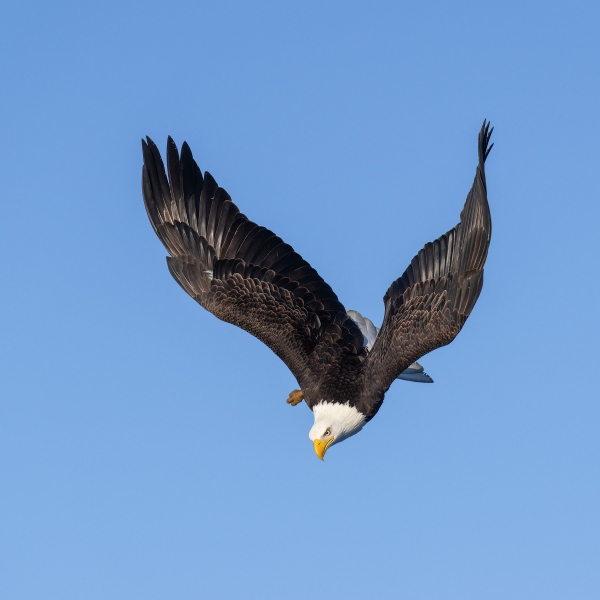
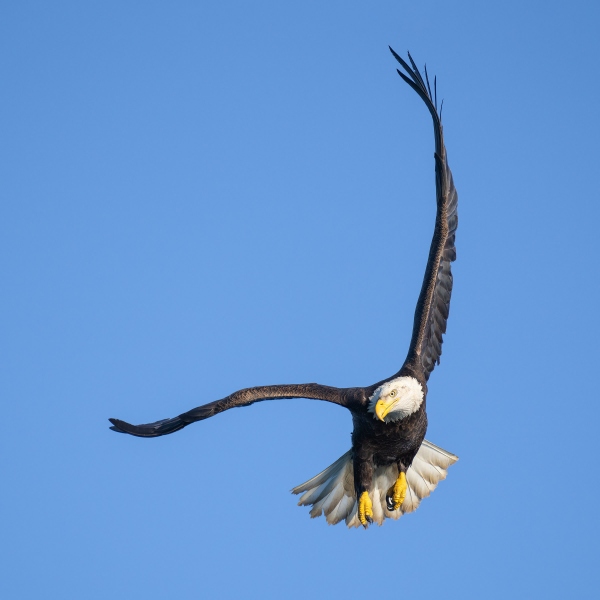













I prefer the first one, it’s a classic!
#2 rules the roost for me. If I was going to put one of these on a wall #2 would take the cake all day everyday. Just me.
Really love the deep V shape for the dive on Image No. 1.
Both great images, but rocking the boat, I’m going to say I prefer Image two… purely and simply because that single foot in the first image, really bugs me!
HI, Number one the best, super angles and great sky background helps the eagles stand out.
Thanks, Don.
With love, artie
#2. As a pilot , can appreciate and envy the precise flight control, coordination, and scanning. Oh, also the diagonal placement of the wings, focus, etc, etc. Beautiful.
I prefer image #1, it appears to be a more natural/comfortable position for the eagle. Number two looks a little bit awkward as the eagle is looking in the opposite direction to which it is flying.
Artie
I love image #1 it shows the determination and the mission he’s on and the look says it all. Image #2 isn’t quite as intense however showing more tail and feet is really nice. I am however confused within only a few minutes you went from 1/3200 to 1/500 sec and the same iso however wide open on the the 2nd. The sky looks the same had the light changed that much?
Always with love b
Thanks, Bob. Good that you were confused. So was I. I have corrected the EXIF for Image #2.
with love, artie